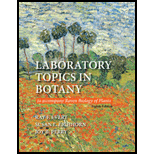Solutions for Laboratory Topics in Botany
Browse All Chapters of This Textbook
Chapter 1 - Botany: An IntroductionChapter 2 - The Molecular Composition Of Plant CellsChapter 3 - The Plant Cell And The Cell CycleChapter 4 - The Movement Of Substances Into And Out Of CellsChapter 5 - The Flow Of EnergyChapter 6 - RespirationChapter 7 - Photosynthesis, Light, And LifeChapter 8 - Sexual Reproduction And HeredityChapter 9 - The Chemistry Of Heredity And Gene ExpressionChapter 10 - Recombinant Dna Technology, Plant Biotechnology, And Genomics
Chapter 11 - The Process Of EvolutionChapter 12 - Systematics: The Science Of Biological DiversityChapter 13 - Prokaryotes And VirusesChapter 14 - FungiChapter 15 - Protists: Algae And Heterotrophic ProtistsChapter 16 - BryophytesChapter 17 - Seedless Vascular PlantsChapter 18 - GymnospermsChapter 19 - Introduction To The AngiospermsChapter 20 - Evolution Of The AngiospermsChapter 21 - Plants And PeopleChapter 22 - Early Development Of The Plant BodyChapter 23 - Cells And Tissues Of The Plant BodyChapter 24 - The Root: Structure And DevelopmentChapter 25 - The Shoot: Primary Structure And DevelopmentChapter 26 - Secondary Growth In StemsChapter 27 - Regulating Growth And Development: The Plant HormonesChapter 28 - External Factors And Plant GrowthChapter 29 - Plant Nutrition And SoilsChapter 30 - The Movement Of Water And Solutes In PlantsChapter 31 - The Dynamics Of Communities And EcosystemsChapter 32 - Global Ecology
Book Details
Laboratory Topics in Botany familiarizes students with recent advances in botany, while maintaining a strong emphasis on the basic facts and principles necessary for a sound foundation in the plant sciences.This manual complements Raven Biology of Plants, Eighth Edition, and has been updated to reflect the changes made to the textbook.
Sample Solutions for this Textbook
We offer sample solutions for Laboratory Topics in Botany homework problems. See examples below:
Genetic code is a set of rules that translates the nucleotide sequence of DNA into the amino acid...Name of the organic moleculeStructural subunitsPrincipal functionCarbohydratesSugarPrimary...Prokaryotic cells are the primitive cells that are different from the eukaryotic cells in many...Water potential (ψw) is defined as the free energy of water or tendency of water to move freely from...First law of thermodynamics: The first law of thermodynamics states that “energy cannot be created...The primary steps for respiration are as follows: The complete oxidation of sugar or other organic...The main events that occur during glycolysis are as follows: In Reaction 1 of glycolysis, a...Plants convert light energy into the chemical energy during photosynthesis. Photosynthesis occurs in...The haploid cells are the cells that consist of a single chromosome set. The diploid cells are the...
DNA replication results in the synthesis of two identical replicas of DNA from the parent DNA. It is...Novel genotypes can be created from virtually any organism by recombining the DNA from the donor...Although Darwin was not the first person to propose theories on evolution, his theory differed from...Binomial nomenclature was introduced by Carl Linnaeus who attempted to name and describes all known...Prokaryotes are single celled simplest organisms that lack a nuclear envelope bound nucleus and...Fungi include multicellular eukaryotes that include many characters similar to animals than plants....Some of the ecological importance of algae is as follows: Algae form the prime contributors of...The general characteristics of the bryophytes are as follows: Bryophytes do not have a true vascular...The pivotal steps in the early history of plant evolution contributed to the success of vascular...Seed: The ovule of a plant is developed into a seed that consists of the embryo and its food supply...The flower is a shoot with growth of limited duration or a determinate shoot that bears sporophylls....The major lineages of angiosperms are as follows: Basal grade angiosperms Magnoliids Monocots...At least 11 different independent centers have been identified throughout the world where...In biological pattern formation, polarity serves as a key component. The polarity fixes the...Meristem: Most of the plant development takes place after the process of embryogenesis through the...The principal types of root systems are given as follows: Tap root system Fibrous root system. The...In the shoot apical meristem of the angiosperms, the corpus and the parts of the tunica layers over...The differences between the annuals, biennials, and perennials are given as follows:...The six major groups of plant hormones are given as follows: Auxins Cytokinins Ethylene Gibberellins...A growth response by a plant involving curving or bending in response to a unidirectional stimulus...Every living organism requires essential nutrients for growth and multiplication. The elements...Transpiration is the process that involves loss of water in the form of vapor from the plants...The scientific study of interactions of living things with each other and their relationships with...Biome is the terrestrial ecosystem or a type of large ecological area with animals and plants that...
More Editions of This Book
Corresponding editions of this textbook are also available below:
Bio Plants 7e
7th Edition
ISBN: 9780716710073
Laboratory Topics in Botany
7th Edition
ISBN: 9780716762058
Raven Biology of Plants (Loose-Leaf)
8th Edition
ISBN: 9781464117800
EBK RAVEN BIOLOGY OF PLANTS, 8E
8th Edition
ISBN: 8220100601576
EBK RAVEN BIOLOGY OF PLANTS, 8E
8th Edition
ISBN: 9780100601574
Biology of Plants
8th Edition
ISBN: 9781429219617
Launchpad For Biology Of Plants (twelve Months Access)
8th Edition
ISBN: 9781319088514
EBK RAVEN BIOLOGY OF PLANTS, 8E
8th Edition
ISBN: 9781464117886
BIOLOGY OF PLANTS-TEXT ONLY
6th Edition
ISBN: 9781572590410
Related Biology Textbooks with Solutions
Still sussing out bartleby
Check out a sample textbook solution.
